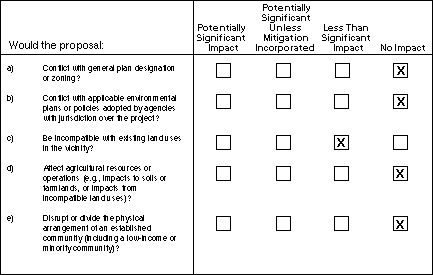
I. LAND USE AND PLANNING

The majority of the lands along the proposed power line are designated in the San Jose 2020 General Plan as Light Industrial. The Bellarmine College Preparatory School site is designated Public/Quasi-Public, and other areas are designated combined industrial/ commercial and general commercial. The proposed power line crosses the Guadalupe River corridor, which is designated as Public Park/Open Space. Zoning along the proposed power line is predominately industrial; the zoning code does not regulate the placement of power lines. Because the proposed power line would be constructed primarily by rebuilding existing power and distribution lines, land uses would not be changed. New power lines would be added (along W. Taylor Street) where the primary land uses are industrial. The project would therefore have no impact with respect to compatibility of the proposed project to general plan and zoning designations.
Portions of the power line route lie adjacent to the Julian-Stockton Redevelopment Project area. Item "G" in the Summary of Proposed Actions from the Julian-Stockton Redevelopment Plan states that the Redevelopment Agency will remedy, as necessary, conditions causing blight by installation and relocation of certain necessary site improvements, utilities, and facilities (PG&E, 1997, p. 99). The section of the project area within the jurisdiction of the Redevelopment Plan is not identified as blighted, and project implementation is unlikely to create blight since the power line route follows an existing power line corridor. The project would not change the land use within the redevelopment area, and therefore, the project would have no impact with respect to the future redevelopment plans.
It also should be noted that the City of San Jose has not designated the aerial lines along Coleman Avenue for undergrounding under Rule 20, the CPUC rule that provides a mechanism for the replacement of overhead with underground electric facilities, nor has the City of San Jose requested that PG&E continue its feasibility studies for undergrounding the proposed lines to FMC. As mentioned above, discretionary approval of the project is held solely by the CPUC; undergrounding of power lines is not required by the CPUC (PG&E, 1998). No conflict with existing policy will result.
Because there is already an existing substation and power line right-of-way, the proposed project would be as compatible as the existing substation and power line is with other applicable policies or plans such as those related to the Airport Approach Zone of the San Jose International Airport, and the San Jose Redevelopment Agency’s Downtown Strategy Plan 2010. No conflict with policy will result.
Residential uses are considered sensitive receptors and would be affected in the short-term by project construction, as well as by visual and noise effects from long-term operation. These are indirect effects to land use as they potentially affect existing activities associated with residential uses. The project would not directly alter existing residential uses; e.g., would not require moving or destroying any residences. Thus, the impacts to land uses would be less than significant. In addition, the following project proposed mitigation measures would be implemented to further reduce potential indirect impacts of noise and visual conditions on existing land use activities: 1) construct an eight-foot sound wall along Stockton Avenue, which would reduce transformer noise at adjacent residences to levels that would be inaudible during the daytime and evening hours and faintly audible during the quieter nighttime hours; and 2) landscape the portion of the substation site facing Stockton Avenue to reduce visual impacts. In addition to the proposed measures, dust control measures would be implemented to reduce air emissions during construction activities. Expansion of the FMC Substation, as mitigated, would therefore have a less than significant impact on adjacent residential land uses.
For the proposed power line, the land uses along Stockton Avenue are commercial, light industrial, and residential. Between I-880 and W. Taylor Street, land uses are predominantly commercial and light industrial, with some scattered detached, single-family residential uses. On the west side of Stockton Avenue, between Emory Street and W. Taylor Street, the land uses are mostly residential. Bellarmine College Preparatory School is bound by W. Hedding Street on the north, Elm Street on the west, and industrial uses on the east. Residential and public land uses are considered sensitive land uses. The project would not cause any direct change in land use in these areas. Project construction would temporarily increase noise and air pollutant emissions, which would have an indirect impact on land use by potentially affecting (temporarily) activities at those use areas. Long-term changes would also occur along the 115 kV power line alignment along W. Taylor Street and on Stockton Avenue between Taylor Street and University Avenue, where no power line currently exists. Project mitigation measures identified above would also reduce impacts to a less-than significant level.
TOP
| Forward to Next Section (Population and Housing) |
Back to Previous Section (Environmental Checklists) |
Back to FMC Substation Main Page | PG&E Substation Projects Main Page | CPUC Home Page |